The 10 Best Boat Trailer Guides for 2024
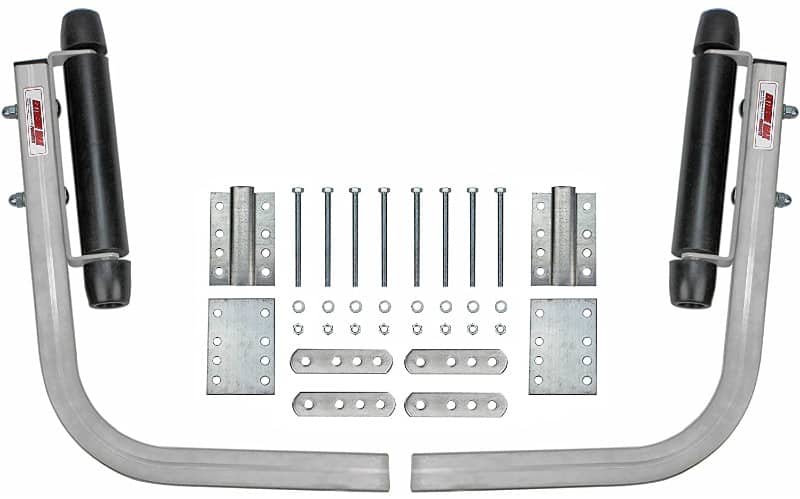
Extreme Max Roller Guide On System
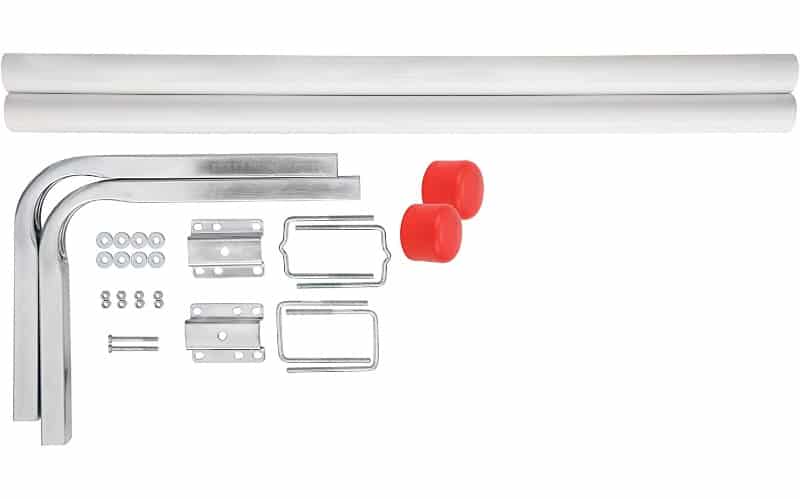
SeaSense Trailer Post Guides
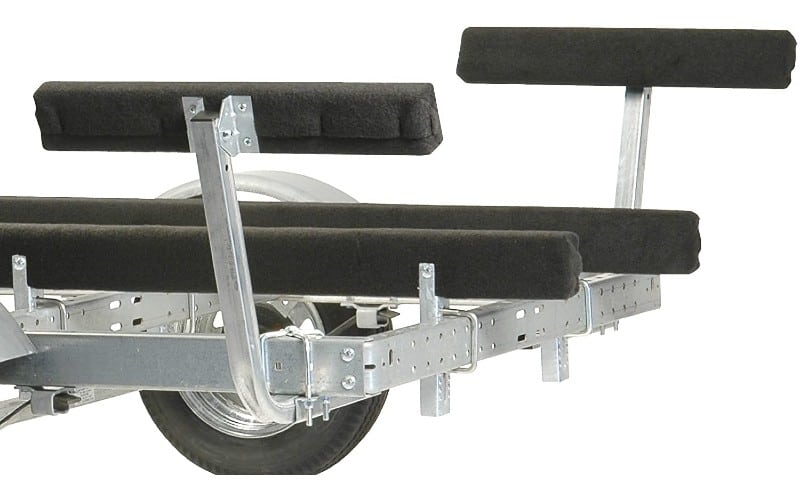
CE Smith Guide On Bunkboard
A good set of boat trailer guides can be invaluable. You already know how troublesome loading and unloading your fishing boat can be at the best of times. Doing it with broken or wonky trailer guides is so much worse. Sometimes a DIY guide made from an old 2×4 will get the job done. But sometimes you want to go all out. A quality product can ensure an easy and safe boat launch. Let’s take a look at the best boat trailer guides on the market.
Extreme Max Roller Guide On System

You may pay a little more for Extreme Max but they’re worth it. The heavy duty roller guides are second to none. They feature a 13″ roller assembly. That means you get up to 14″ (3″ trailer frame) or 16″ (2″ trailer frame) of horizontal adjustment. That’s pretty decent for a medium sized boat. The steel is zinc-coated so please, only use this in freshwater. They resist normal corrosion but in saltwater you’ll have trouble.
The uprights sit up high enough to offer a good line of sight. The rollers are sturdy and support your boat well. The mounting kit contains everything you’ll need to get it attached. If you have a larger frame trailer, you can upgrade to a larger sized kit.
Installation is easy, especially if you’re familiar with installing trailer guides. If not, expect it to only take about an hour to get the job done. The big hurdle here is the included instructions. They’re basically useless. That said, there are numerous mounting plates to fit most trailer frames. In a pinch, you may need to drill some new holes but that’s fine. You should be able to piece it together based on the layout of holes and the picture. If not, Google some guides and a video walkthrough.
SeaSense Trailer Post Guides

The SeaSense trailer post guide is highly visible and extremely useful. The guide poles are 40 inches long. You can also get different heights to suit your needs. SeaSense offers 48 inches all the way up to 60 inches. That’s a pretty impressive size. It’s good for most boaters’ needs for sure.
The LED lighted posts make it extremely easy to see what you’re doing. The LED lights turn from red to green when your boat is ready to launch. As you’d expect, the lighting array is totally waterproof. You can get even the biggest boats lined up straight with these.
The kit includes the mounting hardware to affix the guide poles. The U-bolts are 5-1/4.” The steel supports are 1-1/2″ wide. The pipes are 2-1/2″ in diameter. The poles are steel and the caps are red PVC for visibility. Installation is fairly fast overall. If you follow the directions, it shouldn’t take much time at all. That said, watch out for the nut locks. Some reports suggest they are not super sturdy. The company seems to be mixing their metals. The brackets are steel but the u bolts are galvanized. The nuts can get stripped easily and lose their nylon collars. If that’s the case, you’ll need to buy some replacements. Go for some galvanized nuts to keep everything the same.
In terms of use, these are highly visible. They do a great job of helping you guide your boat in and out of the water. You may want to tweak the caps, though. Because the poles are hollow, when you hit the water the air gets pressurized. That will blow the red caps off the top. Drill a small hole in each one to prevent that from happening.
CE Smith Guide On Bunkboard

For price and function, CE Smith has what you need. This bunk board guide system is tough and easy to use. It features 2” x 4” x 24″ boards. They’re made of untreated yellow pine. They’re upholstered with marine grade carpet to ensure smooth support for your boat.
The poles hit a height of 21 inches. You can adjust them out to 13 inches on either side. They can fit smaller frames and also some larger sizes. The mounting brackets can handle a frame up to 3 inches by 4/1/4 inches. Also, they can be mounted on top of the frame. This gives you a few more inches of height depending on your trailer. Obviously these aren’t for a giant boat. But a small to medium boat should do well with them. Combine them with PVC pole guides and you should have a really solid launch system in place.
We recommend these for something like a 16 foot fishing boat. This guide should be perfect for a boat of that size. The metal parts are all well constructed. The wood may seem a little rickety depending on the side of your boat and how you load it in. Tight up the screws and you should be fine, though.
In terms of height adjustment, you can always invest in larger u bolts. It’s possible to get this on a larger trailer if you need to. The installation process is an easy one here. CE Smith includes everything you need. It’s pretty easy to follow along with the instructions.
All things considered, these may be the best board style boat trailer guides on the market.
FiberFly Roll On System
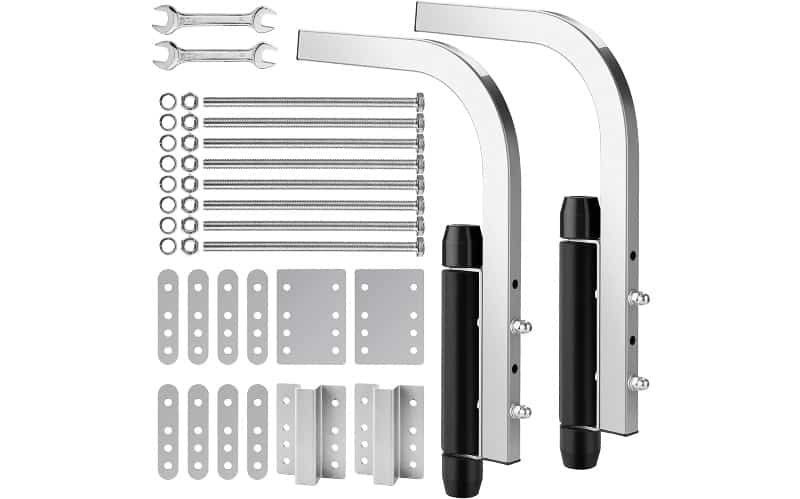
FiberFly goes all out to make sure you have what you need with their trailer guides. The roller system comes with heavy duty 13” roller assembly. There are also 97-degree arms and the necessary nuts and bolts to fully attach the rollers. The full mounting kit is included. They even include two wrenches. You can upgrade to a 6” bolt kit if you need to.
The set up offers up to 14″ (3″ trailer frame) or 16″ (2″ trailer frame) of horizontal adjustment. It fits bunk or roller-style trailer frames up to 3″ wide x 4. 25″ tall.
The steel is zinc-coated for strength and corrosion resistance. Keep in mind that means it was designed for freshwater use. If you take this to the sea, you risk serious corrosion damage. Saltwater is going to eat through this pretty quickly.
In terms of use, the rollers are tough and reliable.They do a good job of keeping your boat straight and centered. Bumps and wind won’t cause a problem when trying to get back on. Your boat should ease on and off with little effort. Plus the rubber is gentle enough that you won’t have to worry about scrapes.
The uprights are a handy tool at launch. They give you a decent line of sight for getting the boat on the water. Installation is also very straightforward. If you’ve ever put guides on your trailer before, this is a breeze. And even if you haven’t, it’s pretty self explanatory.
Extreme Max Single Post
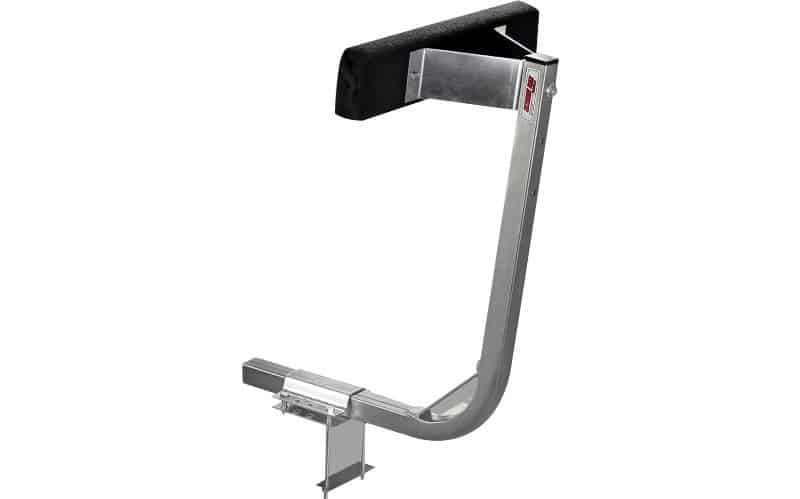
For a solid and sturdy boat guide, Extreme Max has you covered. This single post comes with an 18” carpeted bunk board. All the mounting tools are included in the kit as well. You can adjust the size vertically from 19 inches up to 25 inches. They will fit bunk or roller-style trailers up to 3″ wide x 4. 25″ tall.
You’ll want to use these on a 14 foot to 16 foot trailer. The hardware included will allow it to attach to a 2 inch to a 3 inch frame. If you have a larger trailer, you can still upgrade. 5.25” and 6.25” kits are available. That said, even though there are a number of brackets, you may need to make an adjustment. As you may know, not all boat trailer frames are created equal. It’s possible you may have to drill a new hole or two to get these attached. The boards themselves have the potential to spin on the vertical. A second hole drilled in that support may be needed as well.
The kit is strong, Extreme Max makes a tough product. Even if you do need to drill a new hole, expect it to be sturdy. That said, we have heard that some people have had experience with them being a little loose. Depending on how committed you are, this may not be an issue. They can be welded in place if you like the overall performance. That ensures a serious hold for a long-lasting guide. Of course, that means you’re 100% committed at that point. We’re not suggesting you weld them, and you probably don’t need to. But it is an option some owners have tried for added strength.
The guides themselves are made from pressure-treated wood. Marine carpeting covers the wood to ensure a gentle and smooth guide. This allows your boat to ease on and off with no troubles. You should be able to adjust to a perfect height for most boats.
Tie Down Engineering High Impact Pontoon Trailer Guide On
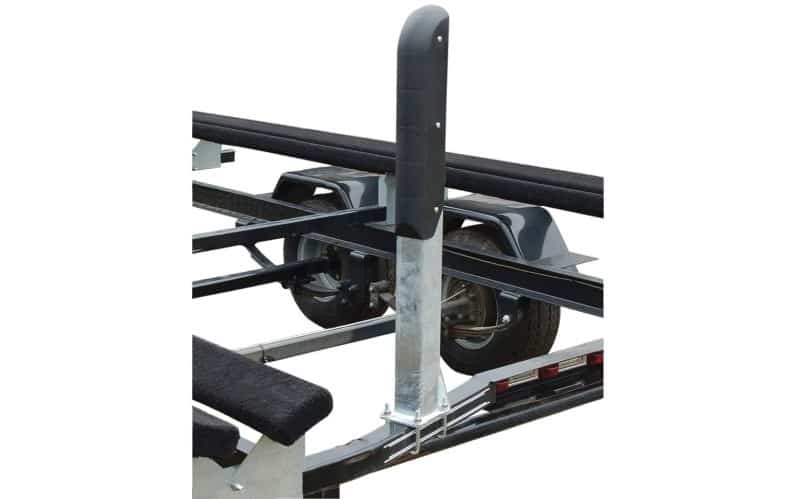
Tie Down Engineering’s posts are designed for pontoon boats. The posts are meant to be mounted on the frame between the pontoons. The posts are made of galvanized steel for strength and durability. Molded PVC has been applied over the top. This ensures your boat hull won’t be scratched up.
Your trailer frame should be 2 inches wide and 2 to 3 inches high for the mounting to fit. Hardware is included for those sizes. You could potentially mount it on a wider frame, but you’ll need a different mounting kit. We recommended giving a couple of inches of space on each side. That way they still center your pontoon boat but offer wiggle room. On a windy day, this can make things much easier.
We have to point out that some people have had issues with these being shipped poorly. In the past it seemed like the company was packing these too tightly. The result was a lot of dings and scrapes. Product arrived damaged and unusable. This didn’t happen to everyone, but it was a concern.
Installation of these is easy enough. Just make sure all the parts are present. You may need to upgrade your u bolts if you have a wider frame.
CE Smith Jon Boat Bunk Support
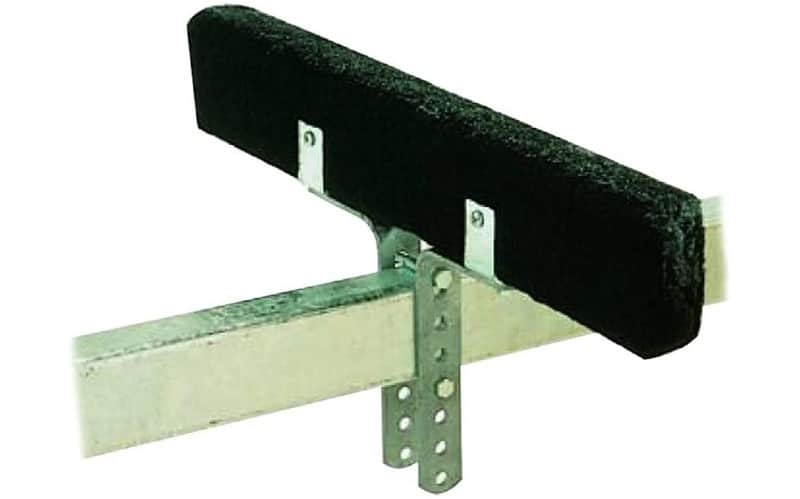
Sometimes you don’t need to go out and buy an entire new set of guides. If you need some support for the front of your Jon boat. When you need to guide in a flat bottomed Jon boat and keep it supported, this is perfect. The board is made from untreated yellow pine. It’s covered in marine grade carpet. That means it won’t damage the bottom of your boat when it slides into place.
The bracket is made of galvanized steel. It’s incredibly tough and can stand up to a lot of abuse. It’s corrosion resistant in fresh water. Keep it away from saltwater, however.
These supports are cheap and easy to install. They do need to be used in conjunction with additional guides, however. These are meant to support the front of a flat bottom boat. They help you ease it in and out of the trailer. But they don’t offer any kind of a visual guide for loading your boat. Your best bet is to use this in conjunction with another kind of bunkboard and posts.
Hecasa Boat Trailer Guide Poles
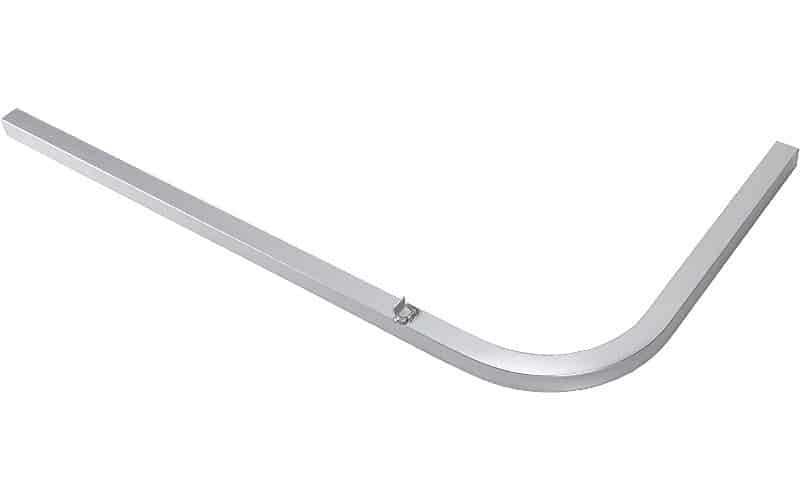
If you need something simple and to the point, here you go. Hecasa’s guide poles are about as basic as basic gets. They’re literally just aluminum poles. Not fancy, right? Sometimes that’s all you need. Because they’re made of aluminum, you can expect them to stand up to the elements.
The poles measure at 1-1/2” square aluminum tubing. They feature 1/8” wall thickness and are 46” tall and 24.5” wide. You get two in a pack and that’s it. That means there is no hardware included. For some, that’s a deal breaker. But if you want to take this job into your open hands, it’s ideal. This means you don’t need to worry about whether or not the hardware of a kit fits your frame. You can make it fit on your own with the right bolts you pick yourself.
Once you have them installed, you can slide PVC pipe over the top. There are tapes on the side to prevent the pipes from sliding down too far. That ensures a more gentle contact with your hull. This isn’t really made clear anywhere in the product literature, but that’s what you want to do. Like we said, this is just barely a step above a DIY project. Basically, you’re paying for aluminum that has been cut and bent to the size and shape you need for a trailer.
Be cautious of the size of your boat with these. Since they are aluminum, they do not have the strength of steel guides. Because they’re so tall, you may be tempted to use them with a bigger boat. But the size could cause them to bend.
Fulton Economy Boat Trailer Guides
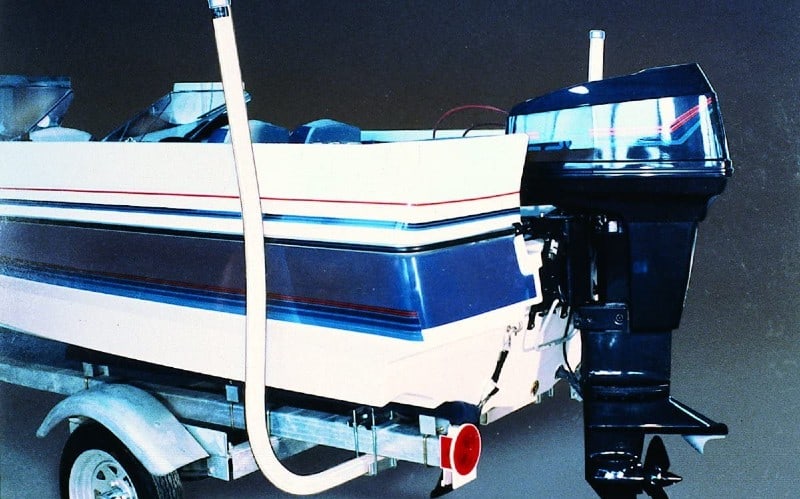
This may be one of the best pole guides on the market. It’s simple, flexible, and noticeable. They’re extremely easy to install no matter what your skill level is. That said, you’re going to need some hardware. You may need to pick up some extra bolts. Also, there are holes in the post that seem to have no purpose. You may want to tape those up. The mounting bolts in place and should be sturdy once you have it ready to go. You may need to add some new holes depending on the design of your trailer frame, of course.
You’ll need to adjust them a few times to get them at the proper tension against your boat. They’re not the strongest material in the world, but they are durable. Because it’s PVC it won’t scratch your hull. Better yet, it can handle freshwater or saltwater. You can mount them on a frame with a height of five inches and a width of three inches. You can adjust the width on either side up to 10 inches.
Once installed, it’s pretty easy to line up the boat. The goal post design is easy to aim for.
Kuafu Board Trailer Guide
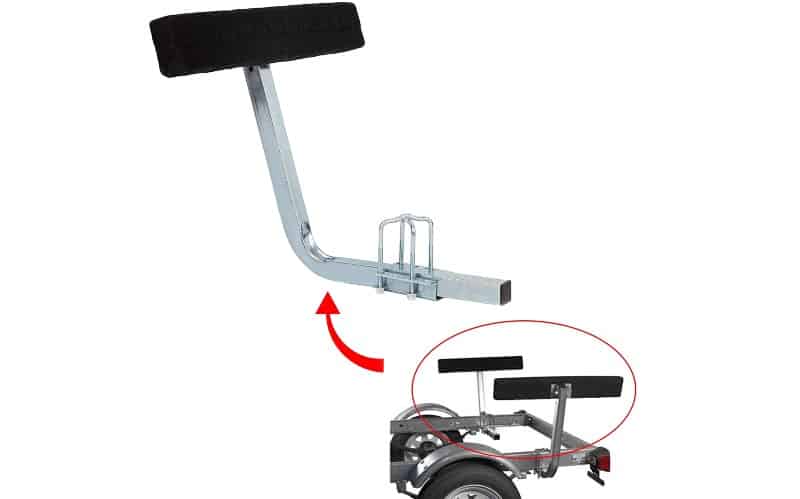
Kuafu offers a high quality product at a good price. They also have a 30-day, no questions asked guarantee. It’s not a long time to make a decision, but the no questions asked part is a good feature. Install them, use them for a few days, and see what you think. If you don’t like them, you lost nothing. That said, we think you probably will find them to be a top quality set of guides.
The clamps that secure the arm to your trailer are well manufactured. Once you have it secured in place, expect a very solid guide. There is much less wiggle than some other models produce. The metal is zinc-plated for corrosion resistance. The company boasts that it can stand up to saltwater, but we find zinc-plated metal less than ideal in the ocean.
The carpeting is stapled onto the boards and we have to point out a weird flaw here. For some reason it’s stapled on the flat side of the board against the boat. So the staples have a chance of scraping your hull here. It’s a weird oversight and doesn’t make a lot of sense. We’d suggest re-wrapping the boards and then stapling the carpeting yourself. Staple it on the back and you should have no issues.
Installation is straightforward. There are no instructions included, so if you’re not confident with this kind of work, that could be a stressor. Overall, it’s easy to figure out, though. In a pinch, you could look up a video on the internet.
Things to Remember About Boat Trailer Guides
Not every boat trailer guide is going to work with your trailer. Unfortunately, there are literally hundreds of different trailer sizes and shapes out there. You’ll need to take some close measurements to ensure the right fit and right function. Here’s what you need to look out for.
Matching Guides to Boat Trailers
There are three basic styles of boat trailer load guides. Each one has its merits. In some cases, it may just be what kind you like best. Others work better with certain trailer styles.
Roller Trailer Guides
Boat trailer roller guides attach to your trailer on a post like any other guides. The surface supporting your boat’s hull is a spinning rubber roller. These can be up to 12 inches in length. They offer firm support. Because they are rubber and they roll, they offer a smooth transition for your boat. Rubber rollers are gentle and sturdy. They tend to be a much better choice for larger boats. That doesn’t mean they won’t work for smaller boats. But as the boat size increases, you want to stick with rubber roller trailer guides.
You need to match the roller size to your boat size. Smaller rollers will be far less sturdy for a bigger boat. Another concern is visibility. The guides help you get the boat on and off by establishing a line of sight. You need to see the guides to help get your boat on and off the trailer. Roller guides tend to be harder to see than other styles.
Bunk Trailer Guides
Trailer bunks have a bunk board that supports your boat. This is what the name suggests – a wooden board. Bunk guide ons are usually covered in marine grade carpet for smoothness. This makes them less likely to scratch your boat.
They make use of an adjustable bracket that you can raise or lower so it supports and guides your boat as needed. You need more of these guides if you have longer guides. The upside is that these are typically cheaper than other guides. Also, in a pinch, these are the easiest to make on your own. You just need wood and carpet. But they can fall apart after a while as well. Cheaper bunk boards will crack or rot. The carpet can wear thin as well.
Post Trailer Guides
Post guide ons the best for helping you see what you’re doing. Like a bunk guide, they feature a vertical metal post. However, the boat trailer guide posts are typically much longer. The adjustable metal bracket can be raised quite high. That way, as you back your trailer to the water, you can easily see them.
Most posts are PVC. The plastic is sturdy but not meant to handle large boats. If you tried to use a post trailer guide with too large a boat, they could break. Ideally, these are used for smaller vessels. The kind you would have trouble seeing otherwise. The visible post makes it easy to see where the boat is and launch it successfully and easily.
Cost
When it comes to all the expenses of a boat, you can get in deep. The last thing you want to do is break the bank of guides for your trailer. That’s why many boaters opt to DIY some bunk boards on their own. They can be made for just a few dollars’ worth of wood and carpet.
If you want to buy professionally made guides, you don’t need to break the bank. For a small to mid-size boat, you can get good guides for around $100. As your boat gets larger, you’ll need to upgrade a little. That may mean bigger guides, or just more of them. You’re looking at around $100 to $150 or so at this point.
Larger guides shouldn’t cost you over $200. You can find some that cost that much, but they may not be worth the price. That’s not to say they are not high quality. But you should be able to find strong, reliable guides for less.
Installation
You’re going to be attaching the guides yourself. That means you want all the installation hardware up front. Roller brackets, u bolts, everything to get it onto the trailer. The parts need to be made of high quality material as well. A boat trailer guide is useless if it is attached with garbage hardware.
In many cases, installation requires improvisation. Maybe the bolts are too short. Maybe you need to drill new holes. This happens more than you’d think. So be ready to adapt if the necessary mounting hardware isn’t all there.
Ease of Use
This goes hand in hand with installation. Believe it or not, but many trailer guides don’t come with instructions. Or the instructions they do come with are extremely vague. So having a well designed guide is important. Some of them are so easy to figure out, you can just look at them and know what to do. Others take some figuring out. The harder they are to install, the greater the chance something might go wrong.
Likewise, once installed, they need to be pretty intuitive. That’s why something like a bunk board is such a good idea. It’s a flat, carpeted board. It’s hard for that to go wrong. The more complex a guide is, the harder it can be to use properly.
Materials
What your guides are made from is important to how they work. Some guides are made with zinc-coated steel. This offers great support. Sturdy steel can handle the weight of most boats. But remember, it can’t be used in saltwater. Corrosion will eat through this very fast.
PVC is a gentle material. It won’t scratch your boat up like steel will. You also have no worries about corrosion when it comes to PVC. However, your boat will always be tougher than PVC. That means it can break more easily, too.
Aluminum boat trailer guides are good for standing up to the elements. They are lightweight but strong. Many DIY guides are made with some simple aluminum pipe and wood for the boards.
As we’ve already mentioned, wooden boards can warp or break over time. The marine carpet can wear down as well. Rubber rolls are durable but they do wear out over time. Exposure to the elements can dry them out until they crack and break.
We recommend PVC for any posts. It’s the best material for the job. For the metallic parts you want to look at galvanized if you’re near saltwater. Zinc-coated steel can work well for freshwater. Aluminum is also a solid choice.
Lighting
Some trailer guides come with lighting installed. This can be a real helping hand. Posts can change the color of the trailer lights when you reach the right depth for launch or loading. These make doing the job at a glance very easy. You spend less time worrying about whether things are lined up correctly or not. Remember, there may be other people waiting to get on that ramp. Little touches like this can speed things along. Plus, you want to get in or out of the water in a hurry too, right? When you’re trying to load or unload your boat, it can get frustrating. Especially if you’re a first timer, or people are waiting. Lights offer a real helping hand.
Fit
Any good boat trailer loading guides will be adjustable. You should be able to adjust both height and width. But how far they adjust is another matter. Some only offer a few inches of range. Others can offer a considerable amount. You want the maximum range that still offers support. If they move out too far or too high, they could lack sturdiness.
Trailer and Boat Size
The size and shape of both your trailer and boat are key. Your guides are going to be useless if they can’t fit on your trailer frame. Likewise, you don’t want to use tiny roller guides for a 50 foot yacht. And giant rollers would be overkill for a little aluminum fishing boat.
Take the size of all your equipment into consideration. Pay special attention to what you can see when you have a boat on your trailer. The guides are meant to guide. You need to be able so see them and make use of them.
Always take accurate measurements. You need to measure your boat and your trailer. You only have so much room to work with when it comes to trailer guides. If you get the wrong size, they may not fit properly or at all. Every guide should tell you the proper dimensions. Then it’s just a matter of making sure your boat and trailer can work with it.
You really need to consider your specific boat before getting the guides installed. If you have a flat-bottom boat, it needs guides designed for it. This works much differently than a v-shaped keel. If you have a 10 foot long boat, it obviously needs different guides than a 50 footer. Likewise, a personal watercraft can make do with much smaller guides.
The right size guides are important for two reasons. The obvious one is that they help you get your boat on the trailer. But the other is a matter of safety. Once you have your boat on the trailer, guides still have that important job of support. Good guides hold the boat firmly in place. If your guides are too small or loose, the boat can shift. When you’re driving, or if a wind picks up, this could spell disaster. Proper guides keep you, your boat, and other people safe. They may not seem like much, but you should take them seriously.
Check Your Equipment
Boat trailers often spend a long time sitting around. During the off season we tend to store them and forget about them. Always give your guides a thorough inspection at the start and end of every season. If you use rollers, check the quality of the rubber. After too long in the heat, the sun, or dry conditions, rubber wears out. It can become brittle and flaky. If it starts falling apart, it needs to be replaced. Old rollers can damage your boat.
Likewise, check your bunk boards. Boards can go bad without you even noticing. If the carpet holds up, the boards may start to warp and crack underneath. More than one boat had endured boards cracking around the bolts. You’re trying to load your boat and the entire board snaps under the weight. That can result in just a thin layer of carpet between your boat and the metal mounts.
Replace the carpet if it’s starting to wear thin. It not only looks better, it works better. Holes in the carpet expose your hull to scrapes and scratches.
Make sure you check the quality before use. Ideally, check the guides every time you load and unload your boat. It doesn’t need to be an in depth inspection, but have a look. Make sure nothing is broken or loose. Better to find out before your boat starts moving.
Make sure all your brackets are secure. If need be, tighten up any bolts. If things are corroding, clean them up and treat them or replace them.
Look over PVC pipes. They can crack during the cold weather or because of sun exposure. If you have cracked PVC, you should get it replaced as soon as you can.
Boat Trailer Guide Care and Maintenance
Your new boat trailer guides won’t be good for long if you don’t maintain them. For the most part, they’re easy to keep in good working order. But just like your boat or trailer, they do require some effort.
The sun, the rain, the sea, and the hot and cold take their toll. Your big concerns are rust and corrosion. This is followed by general wear and tear. Metal or plastic that bends and breaks. Wood for the boards and carpet or rubber wearing out can also happen.
Most of the trailer guides we listed work well on their own. But not all. You may find having several guide types is best. We think using poles plus either boards or rollers is a great idea. The poles provide a solid visual for you to load and unload your boat. The boards or rollers ensure it slides in smoothly. Not everyone wants to bother with poles, but they really do help. It means you can line up the boat at a glance. That gets you in and out of the water so much faster.
Always check how things are installed once the boat is in place. If it looks off balanced, then something went wrong. Your boat should be straight and even once it’s on the trailer. There should be about a 2 inch gap between the keep and the tongue plate. If it’s closer than that, you should make an adjustment.
Clean your guides regularly. You wash your boat, you wash your car, wash your trailer. Keep them free of dirt and grease. If you do boat in saltwater, always rinse the entire trailer down after use.
Use some rust protection if the guides don’t already have it. A paint job or other coating can help extend the life.
Store them properly during the off season. Protect them from both extreme cold and extreme heat.
The Bottom Line
A lot goes into making a boat trailer work properly. It seems counterintuitive sometimes, given how simple most trailers look. The wheels, the lighting, the paint, it’s all important to ensuring the trailer works. And since trailers can cost thousands of dollars, you want all the pieces to function well.
The best boat trailer guides can do a lot for you. They make launching and loading your boat so much easier. And they keep it safe during travel. As we’ve seen, you have a lot of choices. Make sure you know your measurements for the trailer and the boat to make the right choice. Make sure they’re securely installed and that you know how to use them.
Enjoy your time on the water and stay safe.
Categories: Boats

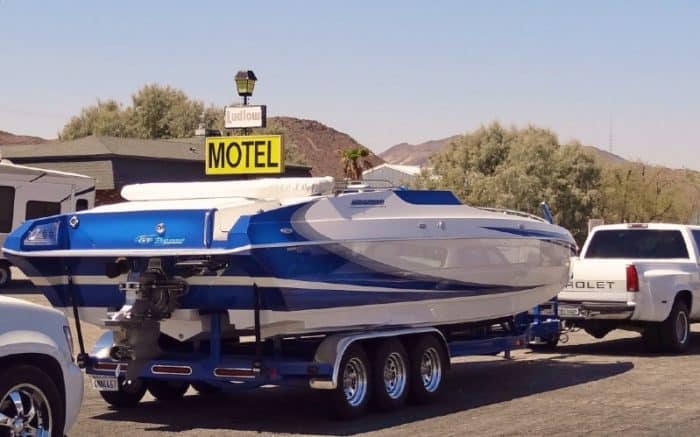












2 Comments
Dalton Bourne on April 17, 2022
These boat trailer rollers from SHORELINE MARINE are much better than the 170 stock Tracker trailer rollers. I replaced the old rubber fender on my boat. This one has 3 pieces, which makes it easy to install. Unfortunately, since my bot trailer is homemade, the mount is wider than the roller and I had to drill holes in the bracket to install the bolts, but it worked fine and worked better than my old stop.
Dalton Bourne on April 28, 2022
I also love its three-piece design that guarantees to reduce abrasion and drag. I never experienced any difficulties in launching my boat with this product.